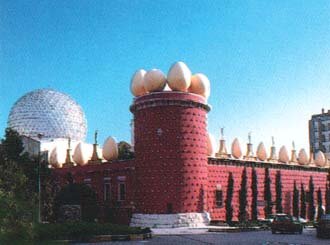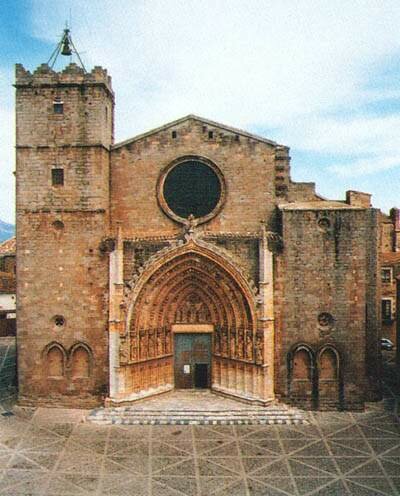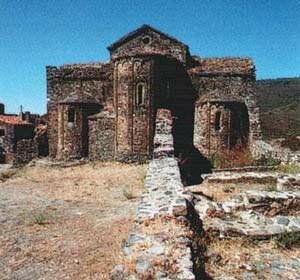
 |
DON'T MISS...: |
DALÍ (FIGUERES AND CADAQUÉS)

During the 1970s Salvador Dalí created and inaugurated the Dalí Theatre-Museum in Figueres, which houses a large collection of his works, from his earliest days and his Surrealist creations through to the works he produced in the last years of his life. After having lived for many years in Portlligat, when his wife Gala died the artist moved for a few years to Púbol Castle, spending the last years of his life in the Torre Galatea house in Figueres, near the Dalí Theatre-Museum, where he wished to be buried.

The Salvador Dalí Museum-House in Portlligat, an essential visiting place to get know the painter's universe, was opened to the public in 1997. The museum-house is located in Portlligat bay, to the north of Cadaqués, the village in which Dalí stayed for lengthy periods during his childhood and youth.
The house is made up of a cluster of fishermen's huts, purchased in various phases, which Gala and Dalí structured in the form of a labyrinth and decorated over the course of forty years, from 1930 through to the 1970s. In the house, visitors can see the painter's workshop, the library, the bedrooms in which they lived their private life, and the garden zone and swimming pool.
RUINS OF EMPURIES
The ruins of the Greek and Roman city of Empúries is near to the Summer resort of l'Escala. Three different civilizations settled here, the Indigetes, the Greeks and the Romans. It is the only Greek city west of Italy that can be seen more or less as it used to be due to the fact that it has been excavated intensively. Part of the immense sea-wall of the old Greek port can still be seen. The remains of the Greco-Roman city cover an area of 40 hectares and is the archaeological site most visited in Catalonia. Its priviled situation made Empúries the gateway chosen by the Greeks to the peninsula as well as witness of the arrival of the Olympic flame for the Games in Barcelona 1992.
Three different civilizations settled here, the Indigetes, the Greeks and the Romans. It is the only Greek city west of Italy that can be seen more or less as it used to be due to the fact that it has been excavated intensively. Part of the immense sea-wall of the old Greek port can still be seen. The remains of the Greco-Roman city cover an area of 40 hectares and is the archaeological site most visited in Catalonia. Its priviled situation made Empúries the gateway chosen by the Greeks to the peninsula as well as witness of the arrival of the Olympic flame for the Games in Barcelona 1992.
ELS AIGUAMOLLS DE L'EMPORDÀ
The "Aiguamolls de l'Alt Empordà" are stretches of fresh water in marsh land in the agricultural area of Castelló d'Empúries and round the Bay of Roses, covering an area of 4.000 hectares, they form the second largest stretch of marsh land in Catalonia and among the fifteenth largest in Spain. Apart from the interesting plants and wildlife to be found there, the "Aiguamolls" are important stopping off places for migrating birds and the only safe place where water birds may rest and feed during their long journey. The Aiguamolls have been declared a Natural Park.
CAP DE CREUS/ PORTLLIGAT/ SANT PERE DE RODES

The combination of both marine and inland environments makes Cap de Creus Natural Park the first of its kind in Catalonia. The total surface area measures 13886 hectares, of which 10813 are inland, and the remaining 3073 hectares are marine. The Catalan seaboard boasts not only a rich bio-diversity, healty marine ecosystem, and exceptional landscapes, but also enjoys unique architectural and artistic achievements. The area is filled with lively, hospitable towns whose traditional recreational opportunities. Cap de Creus Natural Park is a privileged spot that invites visitors to experience this natural and cultural heritage while enjoying the highest quality service. The possibilities are endless, as long as one remenbers to respect the Park's privileged resources. The geological structure of the area is quite particular, and unique in the world in its manifestations. The dominant materials are metamorphic, specially schists, which provides that characteristic dark background of the landscape. One of the main points of attraction of Cap de Creus is the monastery of Sant Pere de Rodes. It dates back to the Romanesque Style (10th-12th centuries) and has been recently reconstructed. Some of the villages in the area show great interest as well: Llançà, Roses, Cadaqués, Port de la Selva, Cadaqués.
PERALADA

Two thousand six hundred years ago, a group of the Iberian tribe of the Indiketes lived in Peralada. At the end of 8th Century A.D., the army of Carlemagne built a fortification there. About the year eleven hundred, Peralada was already settled on the hill, surrounded by walls and crowned by the castle of Toló and the church of Sant Martí. Ramon Muntaner, a famous writer and chronicler of the life and facts of the kings of the Aragon Kingdom, was born in Peralada in 1265. He only lived there until he was twenty, but his Chronicle is full of references and memories of his home town.
VILABERTRAN
 A municipality of the Alt Empordà situated on the north-eastern boundary of Figueres, in the area of the Empordanese plain where the rivers Manol and Muga converge. A large part of the land is used for crop farming, and cattle- and poultry farming complete the economy. The village grew up around the monastery of Vilabertran, an important Augustinian Canon (later a collegiate church), whose abbots had jurisdiction over the area. Ramparts were built on the village walls. The monastery church, a notable example of Romanesque art, later became the parish church.
A municipality of the Alt Empordà situated on the north-eastern boundary of Figueres, in the area of the Empordanese plain where the rivers Manol and Muga converge. A large part of the land is used for crop farming, and cattle- and poultry farming complete the economy. The village grew up around the monastery of Vilabertran, an important Augustinian Canon (later a collegiate church), whose abbots had jurisdiction over the area. Ramparts were built on the village walls. The monastery church, a notable example of Romanesque art, later became the parish church.
CIUTADELLA DE ROSES

On the cultural aspect, the Ciutadella can be pointed out, where you can find the remains of the city founded by the inhabitants of Rhodes Island in the 8 th century BC and the important dolmen of the Creu d'en Cobertella, Trinitat Castle, parish church of Santa Maria in Roses. .
CASTELLÓ D'EMPÚRIES
 In the past, Castelló d'Empúries was the capital of the earldom of Empúries. It is a town of great agricultural, stock-breeding and touristic importance. The parish church Santa Maria, that count Pere 1st tried to convert into a cathedral, conserves its square bell tower which is 69 metres high; the main part of the cathedral has three large naves. This magnificient church is Gothic, but it has a Roman bell tower. The old building of the Llotja, in the Catalan-Gothic style, is currently occupied by the townhall. The "Cúria-presó" (prison) is a fantastic example of the civil Gothic-Catalan style.
In the past, Castelló d'Empúries was the capital of the earldom of Empúries. It is a town of great agricultural, stock-breeding and touristic importance. The parish church Santa Maria, that count Pere 1st tried to convert into a cathedral, conserves its square bell tower which is 69 metres high; the main part of the cathedral has three large naves. This magnificient church is Gothic, but it has a Roman bell tower. The old building of the Llotja, in the Catalan-Gothic style, is currently occupied by the townhall. The "Cúria-presó" (prison) is a fantastic example of the civil Gothic-Catalan style.
LA SERRA DE L'ALBERA I SANT QUIRZE DECOLERA

The Albera range is the name given to the eastern end of the Pyrenees which stretches from the col of El Pertús to the sea. It is a region with a well-defined personality, typically Mediterranean in landscape and ecology. it separates the wide Empordà plain from that of Roussillon and since the signing of the Treaty of the Pyrenees in 1659 part of the French-Spanish border has run along its crest. The Albera range is about 25 km long.
The total surface area of 3428 hectares is divided into two sectors. One is the Requesens-Baussitges sector, the other is the Sant Quirze-Balmeta sector. The area is inhabited by species characteristic of the Mediterranean basin as well as Eurosiberian species found in Catalonia's mountainous areas and damper regions. The streams and rivers are inhabited by turtles.
 The Albera boasts a rich heritage of Romanesque architecture, the style that prevailed during the high Middle Ages when settlements in the area were consolidated. The most outstanding in the nature area is the former Benedictine monastery of Sant Quirze de Colera, documented as far back as the 10th century, of which the magnificient basilican church and remains of the cloister, other monastic buildings and the fortifications can still be seen.
The Albera boasts a rich heritage of Romanesque architecture, the style that prevailed during the high Middle Ages when settlements in the area were consolidated. The most outstanding in the nature area is the former Benedictine monastery of Sant Quirze de Colera, documented as far back as the 10th century, of which the magnificient basilican church and remains of the cloister, other monastic buildings and the fortifications can still be seen.
ALBANYÀ I SANT LLORENÇ DE LA MUGA
 These villages are characteristic due to its wooded landscape and its forest paths which reach farms and romanesque hermitages. The cuisine of its tipycal restaurant and the tranquillity, far from the usual tourist places gives us the possibility to relax. These villages are situated in the area called Salinas-Bassegoda. In Albanyà we find the entry to go to the ancient villages Llorona and Bassegoda. In Sant Llorenç de la Muga we can visit romanesque churches. It is also possible to find remains of megalithic monuments. All this mixture of ancient cultures give to the Alt Empordà villages an special charm.
These villages are characteristic due to its wooded landscape and its forest paths which reach farms and romanesque hermitages. The cuisine of its tipycal restaurant and the tranquillity, far from the usual tourist places gives us the possibility to relax. These villages are situated in the area called Salinas-Bassegoda. In Albanyà we find the entry to go to the ancient villages Llorona and Bassegoda. In Sant Llorenç de la Muga we can visit romanesque churches. It is also possible to find remains of megalithic monuments. All this mixture of ancient cultures give to the Alt Empordà villages an special charm.
| Index of reccommended sightseeings |